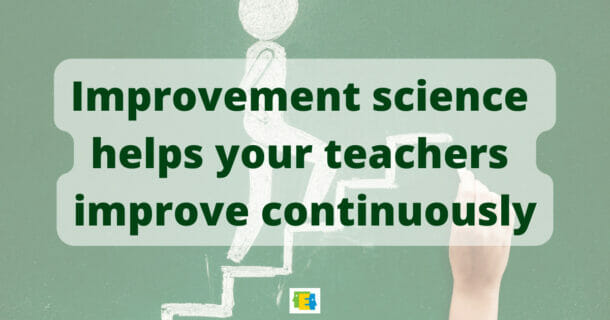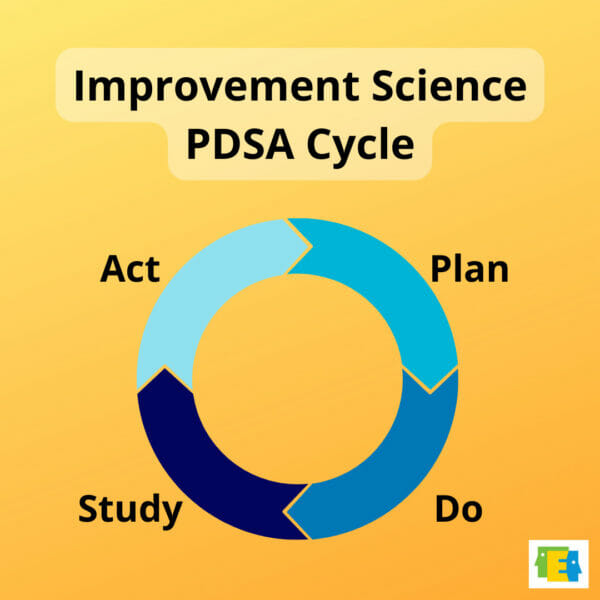How to Help Teachers Use Improvement Science to Get Better in the Classroom

Educators are continually striving to improve their teaching practices. Working towards classroom goals is more effective with a structured process – we have the science to back it up.
Improvement science is an approach to educator growth rooted in data, inquiry, and iteration that teachers can use when developing teaching practices.
Instead of teachers simply trying to strengthen teaching practice without a plan or process, improvement science provides a clear framework for getting better.
This post explains what improvement science is and what it looks like in practice with teachers working on classroom goals.
Continue reading for the benefits improvement science offers and why we at Edthena think it’s key for educator growth.
Improvement science offers teachers a structured process for improving efficiently
We know that effective teaching directly leads to stronger student outcomes. So when educators are working to improve their classroom practices, it’s important that they don’t just try to get better. Teachers must succeed at getting better for the sake of their students.
But developing and refining instructional practice and teaching skills is complex and difficult work for teachers.
And just like finding a destination without a map, achieving a classroom goal is much more difficult without direction.
Teachers working on a specific instructional skill can more efficiently strengthen their teaching practice when they follow a clear process.
Heavily studied by and recommended by the Carnegie Foundation for the Advancement of Teaching, improvement science is a framework that can help teachers bring order and structure to the difficult work of continuous instructional improvement.
The approach involves teachers making predictions about adjustments in teaching, collecting classroom data, and determining the results and next steps as they work toward instructional goals.
This type of process- and data-driven teacher learning and development is baked into coaching models of all kinds, from Jim Knight’s Impact Cycle to Paul Bambrick Santoyo’s Get Better Faster.
A teacher’s map for improvement is clearer, and in turn more achievable, with a plan for moving through learning, implementation, and evaluation.
Plan, Do, Study, Act: The key components of the improvement science model

So what’s the map that improvement science provides teachers for stronger practice and classroom improvement?
The key concept in the improvement science model, popularized by the Institute for Healthcare Improvement, is the PDSA cycle.
PDSA stands for Plan-Do-Study-Act. Teachers can think of it as a mini-experiment on a specific instructional skill.
Let’s break down the improvement science model’s PDSA cycle:
- Plan. Teachers identify a change they want to make to improve their teaching practice, and make a prediction about what will happen when they implement that change in their classroom.
- Do. Teachers do, or implement, the change they planned In the ‘Do’ part of the PDSA cycle, teachers do the change and record what happened as a result.
- Study. In this stage, teachers compare the results of their classroom change to what they predicted. Perhaps the adjustment in their teaching led to the anticipated results, or perhaps it didn’t.
- Act. Teachers decide what to do next, based on what they have learned from studying what happened as a result of their instructional change.
In summary, the Plan-Do-Study-Act cycle in the improvement science approach involves an educator identifying and implementing a change in their teaching, studying the results, and then making adjustments based on what happened.
Improvement science and the Plan-Do-Study-Act approach prioritize the idea that a teacher is constantly experimenting within their classroom.
The lessons learned from one PDSA cycle ideally can lead to another cycle—another mini-experiment to work on teaching improvement.
Make the improvement science PDSA cycle easy for teachers with the right tools
The concepts of improvement science may be relatively straightforward to understand, but building the habits for the Plan-Do-Study-Act cycle requires deliberate effort on the part of the teachers.
Having tools for implementing the structure and process of the improvement science model can help teachers build these routines with less effort and will require less oversight from administrators.
Rapid cycles of improvement and gathering data about actual practice are baked into our tool AI Coach.
Using the best practices of improvement science, the AI-driven coaching cycles guide teachers through self-reflection, action-planning, and data collection as they work on a goal aligned to a specific instructional skill.
This is based on the same key components of the Plan-Do-Study-Act cycle within the improvement science model.
In an AI coaching cycle, teachers upload a classroom teaching video to analyze and reflect on their teaching and potential areas of improvement.
Then, teachers:
- develop a near-term goal and next classroom action steps (Plan)
- enact that change in their teaching (Do)
- document the impact of their change on student learning and outcomes (Study), and
- determine if they will continue the change or try another strategy (Act)
Often, the hardest part of teaching improvement is knowing if a specific action or change is effective. That’s why the coaching cycle within the AI Coach platform supports teachers to plan what data they will collect to measure if their attempted change is working.
Just as importantly, teachers come back to the platform after implementing the change and evaluate the results against their prediction. They’ve collected the classroom data and are ready to determine if their classroom goal has been reached, or if they should try something different.
Administrators get a boost, too, because the AI Coach platform automatically provides the supportive structure and necessary follow-up reminders to teachers in order to help them successfully complete the process.
These are the principles of improvement science in action.
Understanding and using improvement science helps teachers get better more effectively
Improvement science builds on what many educators already do, which is identifying a skill they want to improve and trying something new in their classroom to work on that skill.
However, changing and getting better are hard work and require a lot of thinking.
Having a planned approach to how a teacher will implement and assess the results of a change takes the thinking work off the teacher and provides a map to working on a classroom goal.
Using improvement science to structure teachers’ approaches to getting better for their students can lead to stronger outcomes.



